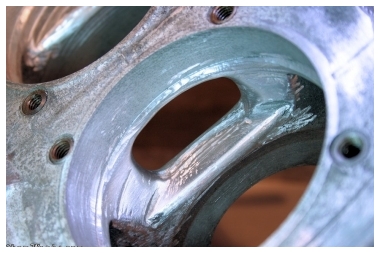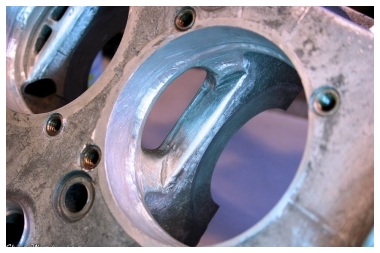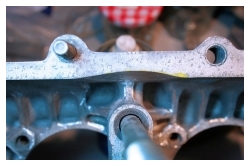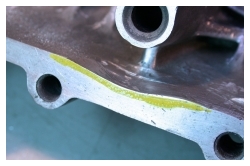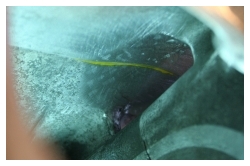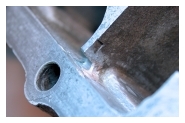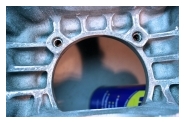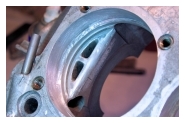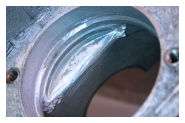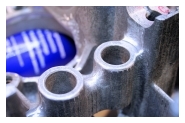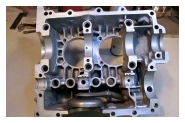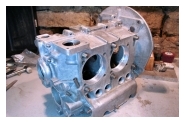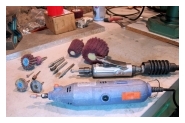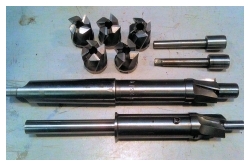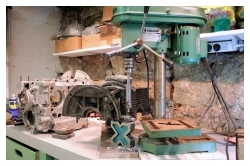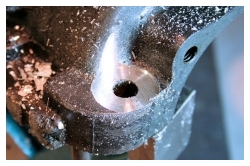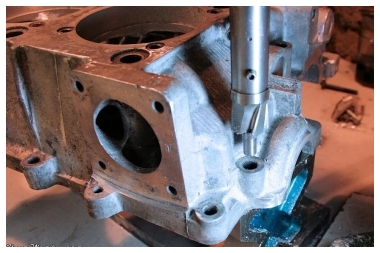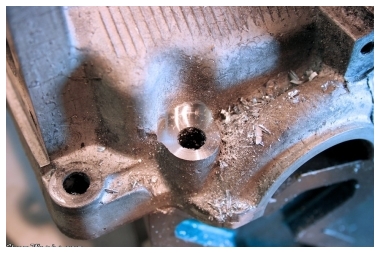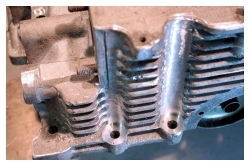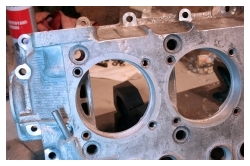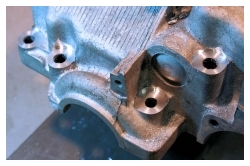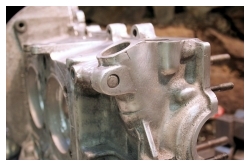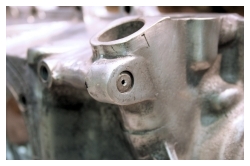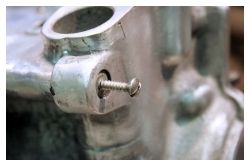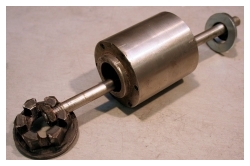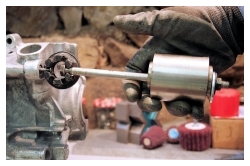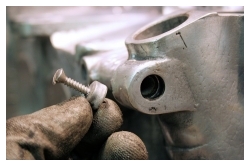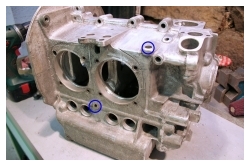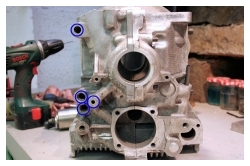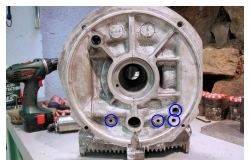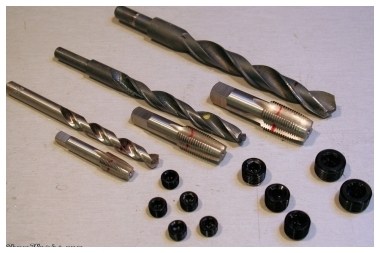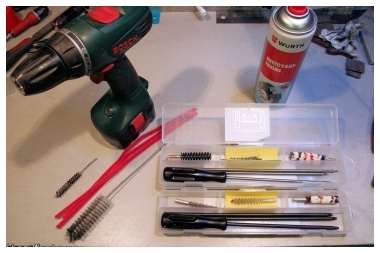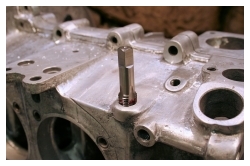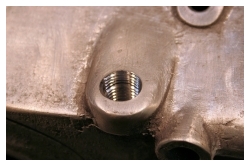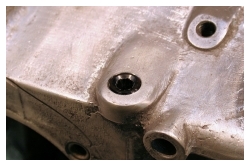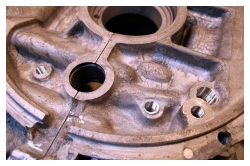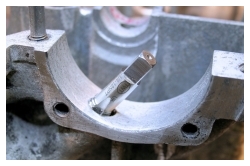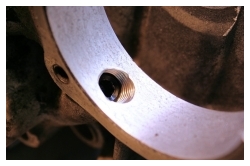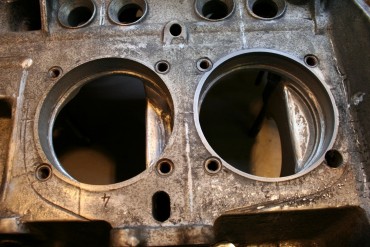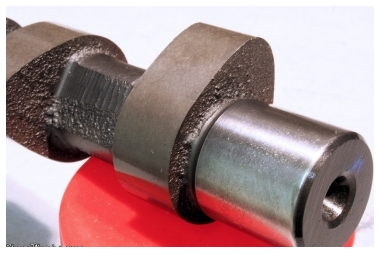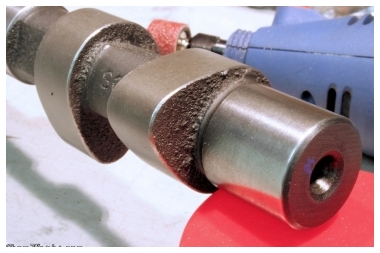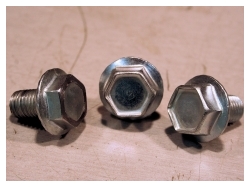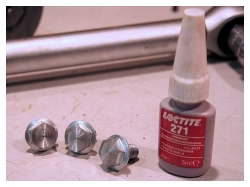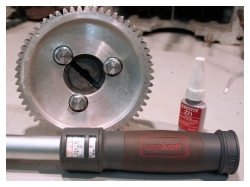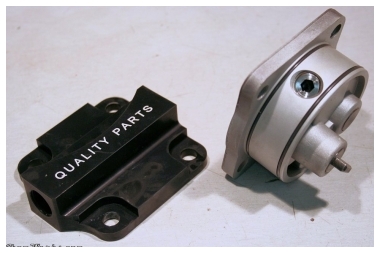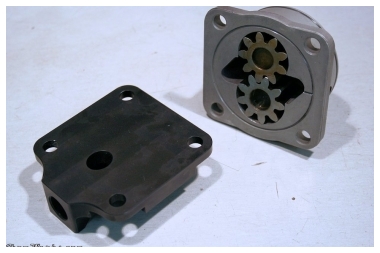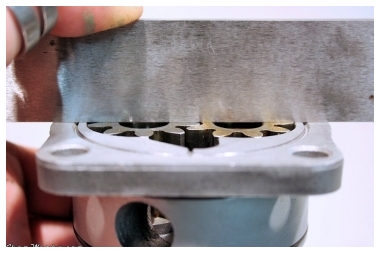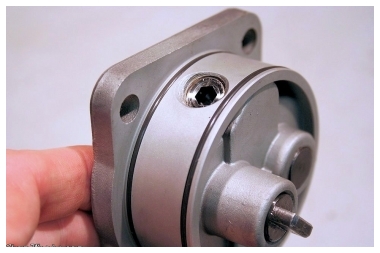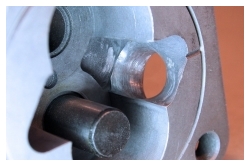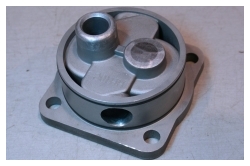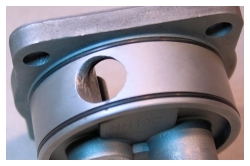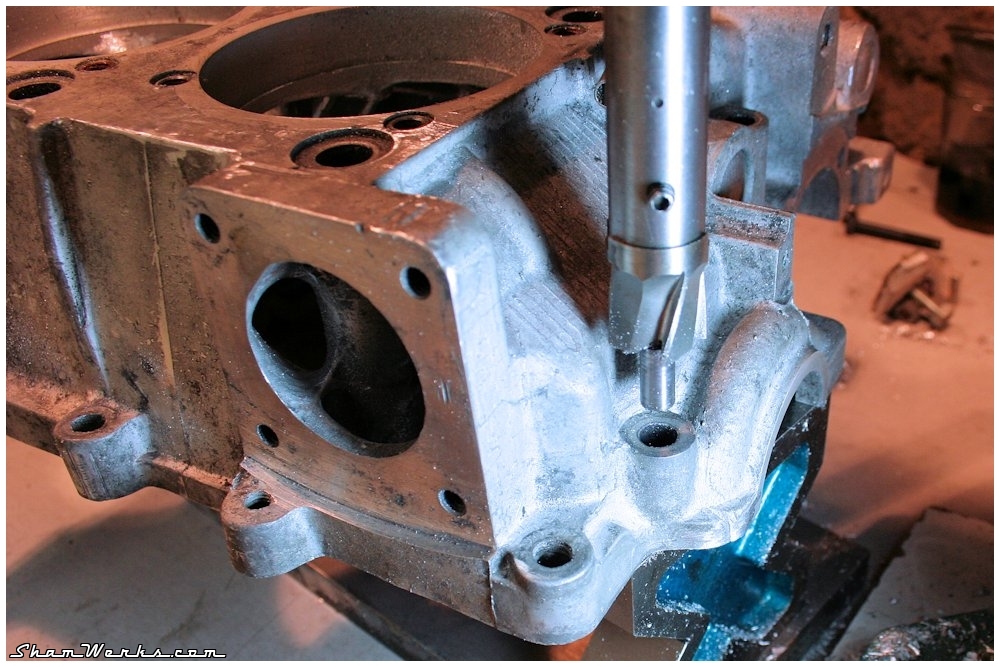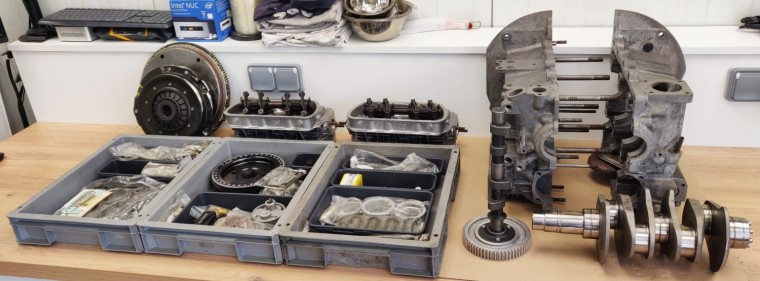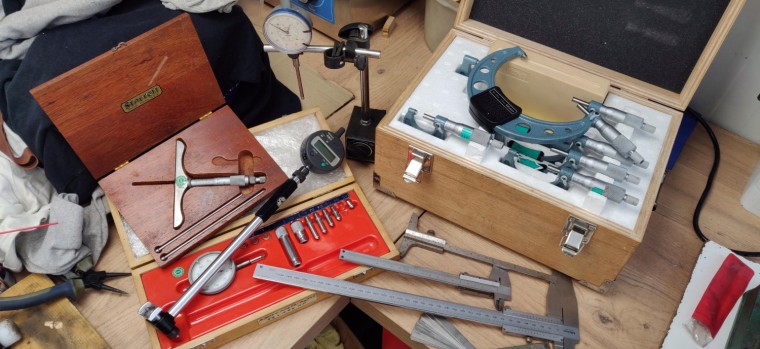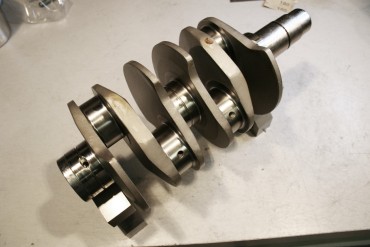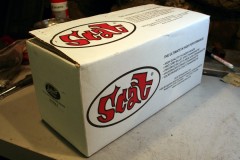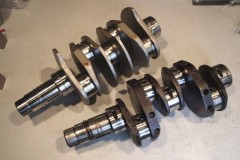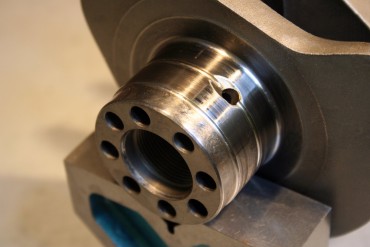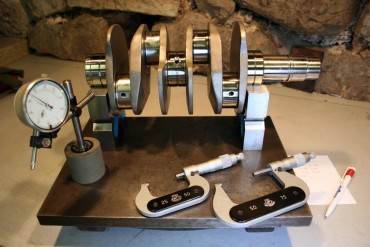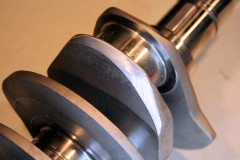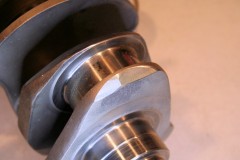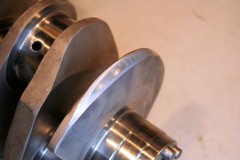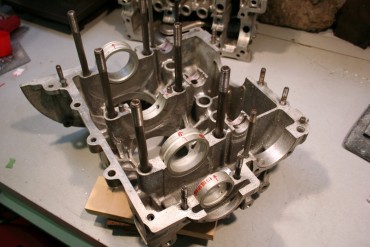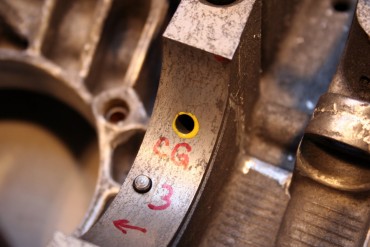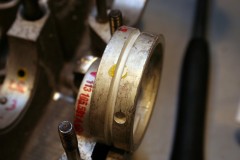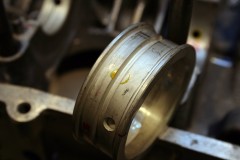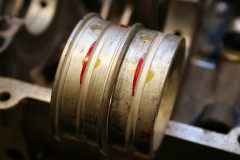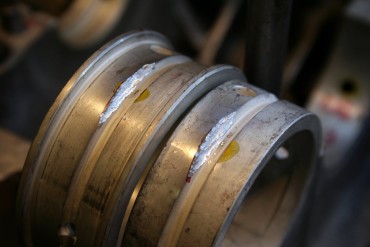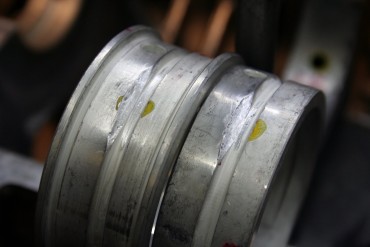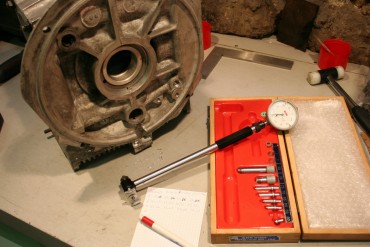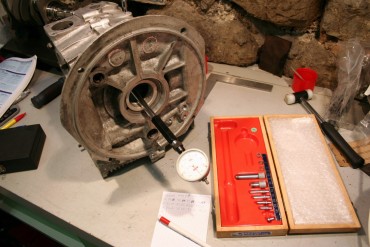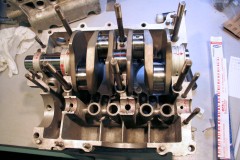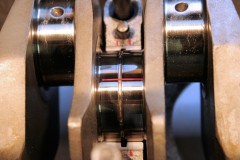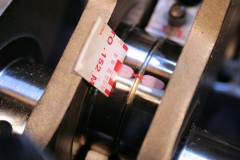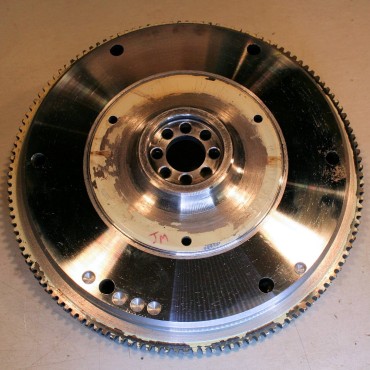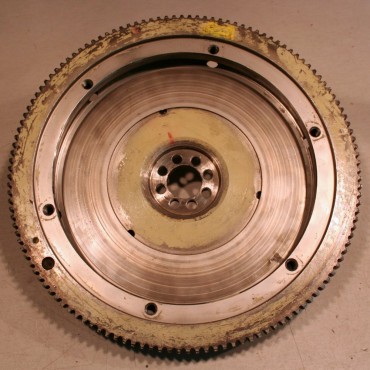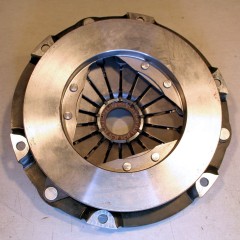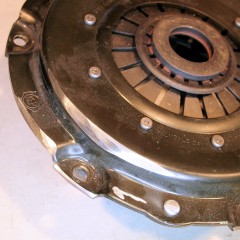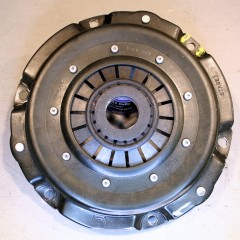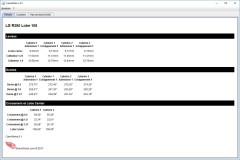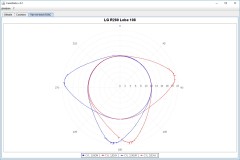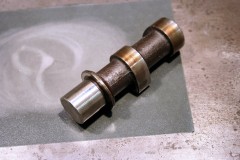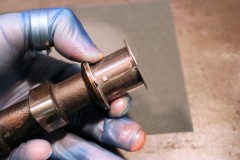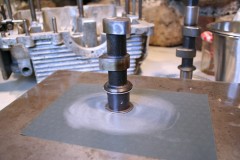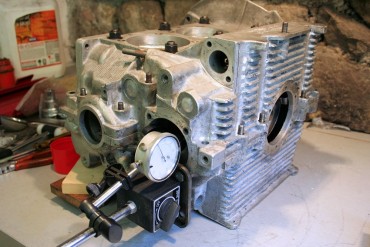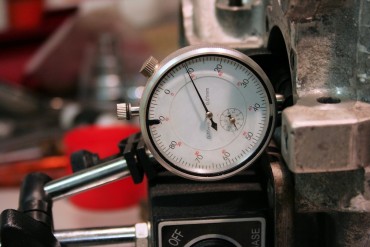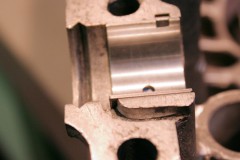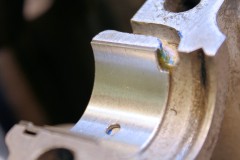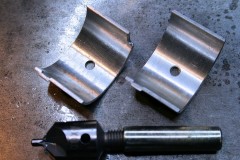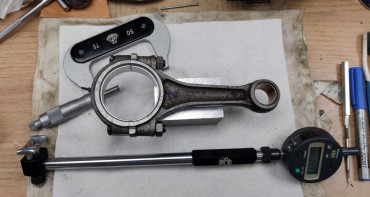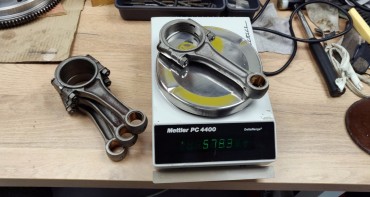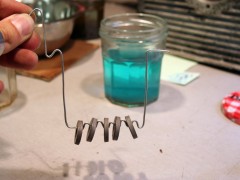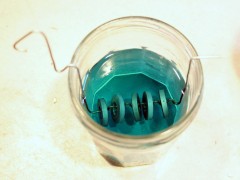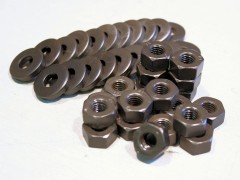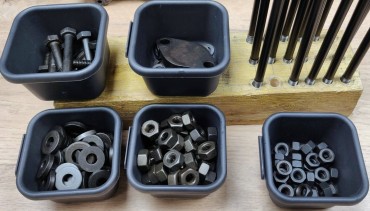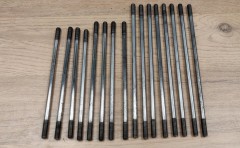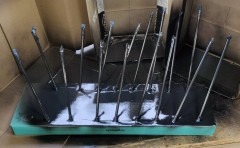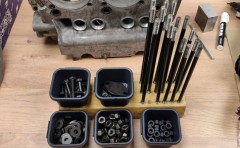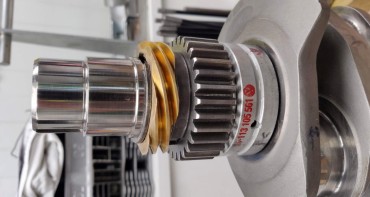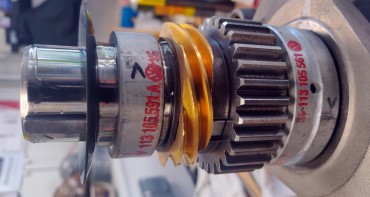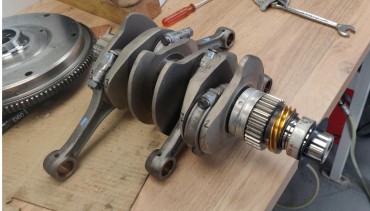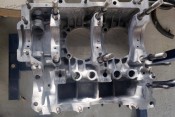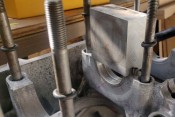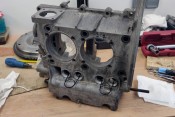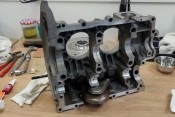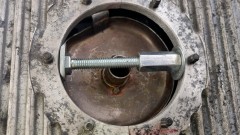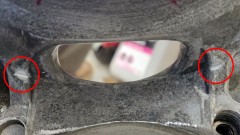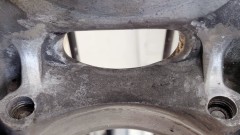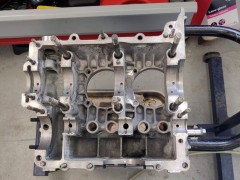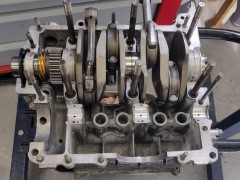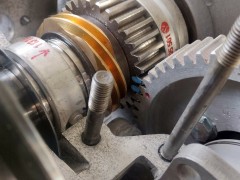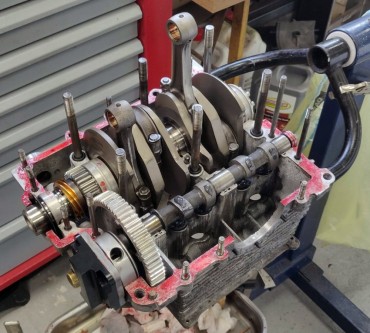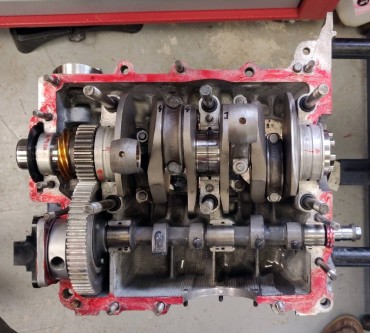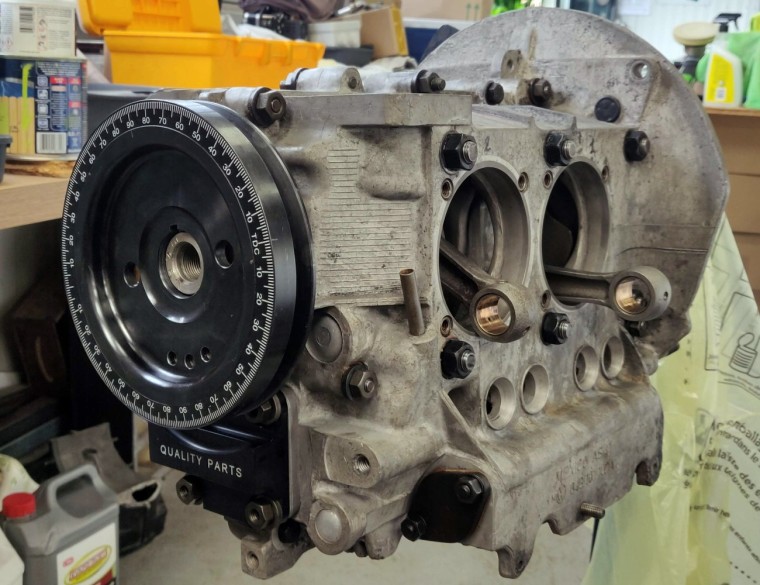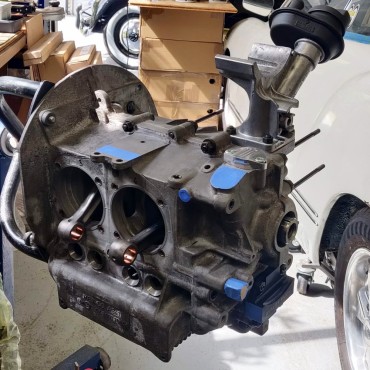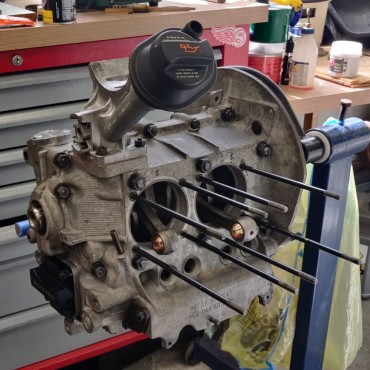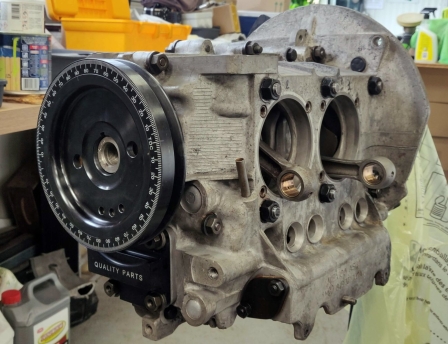Posted on 30/06/2014 at 22:41
Kitty Injection : Engine : 1776 part. 2

1776 / Part. 2
Case Prepping
Crankcase
I kept working on the case :- All edges are smoothed,
- Casting marks are removed,
- The ventilation holes between cylinders 1&2 / 3&4 are widened (the three fingers rule!) and smoothed,
- the oil return hole at the bottom of the partition with the distribution gears is enlarged,
- the ventilation above the central bearing is enlarged.
The global idea is twofold : first, enhance the air flow inside the crankcase to avoid over-pressure, second, ease the return of the oil to the bottom of the case, in order for it to go back in the oil circuit (the oil remaining on the inner faces of the case is useless!).
Smoothing the edges also helps preventing concentration of constraints in the material, and the cracks that could result from them. Well, to be honest, I'm not really too concerned about that on my little 1776!
As a comparison, here is one of the ventilation ports before smoothing...
For the case's exterior finish, I used a fine rotary abrasive brush (on the pneumatic grinder, this baby gotta turn fast!). The objective was just to remove the oxidization and remaining muck after its previouss chemical cleansing...
Berg Conversion
I had my mind set onto using head washers an nuts around the case ("Gary Berg conversion") : the thick washers (4mm) and the 15mm nuts allow a tighter torquing of the case perimeter (2.7mkg instead of the origin 2mkg), leading to a more rigid crankcase.But to do so, one needs first to spot face the case for the washers to lay flat on the material... As I did not really want to go
In order to do so, you would first need the right tool, a 22mm counterboring bit with a 8mm pilot tip (actually fellow enthousiast KY260, advised that Ø23mm is even better, as the washer may be a bit tight with 22mm). Not an easy to find tool, but I finally found it on eBay : a set of 23mm cutters, with two CM3 tool holders and 4 14.4mm pilot tips. At 44€, that was a steal!
As I don't have a mill, I want to use that tool with my drill press ; in order to do so, I lathed down one of the CM3 tool holders to give it a cylindrical end instead of the conical morse one. I also lathed one of the pilot tips down to 8.5mm (that hardened steel was very, very hard to lathe!).
Finally, I have the correct tooling, let's give it a shot! Before I actually modify my crankcase, I did make a few tests on my former, out-of-tolerances case, just to validate the process first. Finally, I found a way to do it, by clamping my drill press down on the bench, turning the drill press head backwards to get enough height, and drilling slowly... I know my assembly will make any proper machinist shiver, but the resulting spot faced areas are really nice and flat and perpendicular : process validity checked!
So, here we go now, same procedure on my actual case. It's actually quite a quick process, except the ones below the case ; some Dremel work was required to free the way for the cutter.
Unpluging the oil galleries
In order to thoroughly clean the oil galleries, and by doing so avoid that some gunk would screw up all the nice work do so far upon engine's first start, you must un-plug the galleries. The operation isn't that difficult if you're careful : first center-punch the plug, then drill it with a 3mm drill bit ; then force-screw a sheet metal screw in that hole, and pull on it with an inertia hammer.Since I did not have an actual inertia hammer, I thew one together with what was available around the workbench... I'm actually pretty happy of that recycling of an old rear-drum 36mm nut.
Cleaning and plugging back the galleries
So, now that the galleries are un-plugged, it's time to clean them, and find a way to plug them back after!Here's the tools of the trade for these two steps...
I ordered plugs from Torques.co.uk (great address I already got fuel fittings from). These are conical NPT 1/8"x27, 1/4"x18 and 3/8"x18. They are anodized aluminium, really nice products ; to be installed with Loctite 577 pipe sealant ; make sure you have the imperial size Allen wrenches to tighten them in!
As for the cleaning of the galleries, any means are good. Myself, I'm first using the compressed air to get rid of as much shavings and dust as possible ; then bottle brushes, shotgun brushes and pipe-cleaning brushes... And lots of brake cleaning fluid ; some WD40 can be used too, to help removing any hardened oil sticking in the nooks and crannies.
To make it a bit easier, I like to mount the bottle/riffle brushes on my cordless electric drill, and then go back and forth in the galleries while turning full speed ; that's the way to go, galleries end up all nice and shiny! (sorry, no picture about it, I could not manage to get a proper picture inside the oil gallery) Next, taping the plugs holes... This operation produces a lot of shavings and dust, so make sure you wait till you've finish this step before actually doing your final cleaning of the galleries!
Prior to taping, you first need to drill the holes : here are the drill bits sizes you'll need for that :
- 1/8" plug : 8,5mm drill bit (11/32"), going 15 mm deep
- 1/4" plug : 11mm drill bit (7/16" ), going 26 mm deep
- 3/8" plug : 14,5mm drill bit (37/64" or 9/16"), going 25 mm deep
You need to be cautious while taping, as it's conical. As per the depth, you need to go little by little : tap a little, test fit the plug, tap a bit more, test fit the plug, et cætera until the plug sits flush with the case when tighten. To make it easier/faster, once the first plug of a given size is tapped, I make a mark on the tap for the next ones! (see previous picture, red marker stripe on the tap) The gallery on the output side of the oil pump needs to be plugged as well. The pump itself is already tapped, but plugging the gallery too will prevent oil pressure from coming back in this gallery, causing leaks and/or oil going back in the case instead of the circuit. I put that plug deep into the gallery, that should help avoiding gunk and debris from stocking up in that dead-end part of the oil circuit.
So here we go gain, NPT 1/4"x18 tap, directly in the gallery without any prior drilling (inside diameter is correct). Half a turn ahead, quarter turn back to get shavings ou, and repeat... The plug will be tightened in the gallery with its dose of Loctite 577 pipe sealant again.
Running in the Cylinders
I then hone the cylinders on the crankcase, to make sure they seat correctly. Some may think it's not necessary, but as I'm trying to do things right...So here we go, honing compound applied with a small brush at the bottom of the cylinder, a fw back-and-forth movements (3cm to the left, 3cm to the right, repeat). Doesn't need much, few minutes per cylinders are enough ; you can see the matte finish on the picture below, showing propper hoining. It's also a good way to check the cylinders aren't resting on the case savers, but well onto the case itself (it not, some Dremel action would be required).
In my case everything looks fine on all 4 cylinders, perfect, validated. Next.
Camshaft
Out of the box, the cams edges are razor sharp, which may damage the lifters upon engine's first start. So I lightly smooth them down with my Dremel and a sanding drum. It doesn't need much, just smoothing down that angle a bit ; I finish it off with some 600 grit sandpaper with a drop of oil.The journals are polished with some 2000 grit sand paper (a worn-out ScotchBrite pad would work too), to remove any imperfection and promote the oil film. If you use sand paper though, make sure you thoroughly clean the part after, as grit particles may get embedded in the material (well, that's more true about the soft material of bearings han the hard steel of the journals!). Assembling the driving gear : the screws delivered with the camshaft have a ring protruding on top of them, which may interfere with the back of the oil pump. Since that ring does not bring anything in terms of resistance to the screws, I lathe it down (well, a file would have done the trick too!).
Finally, a thorough cleaning/degreasing of all the parts (brakes cleaning fluid, acetone), and assembly, torquing the screws at 25nm, with a drop of Loctite threadlock (the stronger, red one - you really don't want these to get loose!). The notch in the camshaft (that drives the oil pump) has to be aligned with the mark on the gear. I give the whole thing a thin coat of WD40 to prevent any oxidization, and I put it aside, in a clean protective plastic bag.
Oil pump
The oil pump is a modified model, prepped by Feller Service (a french perf shop) : it's a Shadek 26mm base, machined to add a couple of O-rings around it (to prevent leaks and cavitation). The pump body and gears are rectified so that the gears are perfectly flush with the body (checked with my trustful rectified ruler).The output is already plugged, with the full-flow output on the anodized black, CNC aluminium cover (tastefully engraved with the name of my fav parts dealer!
More information about this pump on Feller's blog (in french only I'm afraid) ; actually if you give it a close look, my pump cover is somewhere on the last picture, on the right hand side...
Anyway, here's a really nice, highly recommended product, and made in France for once! Still, I make a couple of modifications on it : first, the tear drop shaped input as recommended by Berg, so that the oil arrives nicely all along the gear. I also slightly grind down the rear protruding tenon, to make sure it won't interfere with the camshaft screws. The oil inlet port is aligned with the gallery on the case (see this post by PanelVan) ; I was lucky, I had less than a half millimeter gap, so a light Dremel sanding drum touch in the pump body was enough to align it perfectly.
And that's it, enough for the oil pump, it's ready to install!
To be continued soon!
Posted on 30/06/2024 at 07:44
Kitty Injection : 1776 part. 3 : Short Block

1776 / Part. 3
The Short Block
Actually, the last episode of this series dates from June 2014 ... Yeah, I'm not exactly an example of speed, right?
As a consequence, those of you with a keen eye will note that some photos were taken in my old workshop , and others in the new one...
Come on, let's not lose hope and continue with the closure of the "Short Block".. It's high time we put all these parts together to make an engine: I won't lie, I'm getting a little impatient for this engine to run...
Metrology & methodology
I get everything I can through metrology on this build, so as to avoid any unpleasant surprises - and to satisfy my OCD.So I'm taking out all my metrology tools collected over the years: micrometers and their calibers, bore comparator, adjustable gauges (not in the photo), calipers, thickness gauges, etc... Well, I know that I'm not doing this in a clean room under controlled temperature, nor with regularly calibrated tools, but within a few hundredths I should be pretty good. Obviously this requires a bit of organization; to be able to find my measurements easily, and compare them to the VW tolerances, I note everything down in an Excel table (well, actually a Google Sheet). This allows me to access it from anywhere, note the values in the workshop when I measure them, and check the tolerances at a glance.
You can see the result below, or by following this link to have it in full screen: metrology 1776 KG.
At the time of writing these lines the compression ratio is not correct since I haven't taken care of the cylinder heads yet, but I will update the sheet when I do.
Crankshaft
This is a part that I had to chase for almost 7 months because of a not very well-organized parts dealer... In short, fortunately I have a father-in-law in the US to ensure stewardship on this one! Thank you Yves!So, it's a Scat Volksracer 69mm counterweight crankshaft, "Straight shot" oil galleries and not "cross-drilled", forged in nitrided 4340 chromoly... Beautiful beast. Although the crankshaft is sold as supposedly already balanced, I still got it balanced myself (at Feller's), with its flywheel and clutch mechanism; the damper pulley had already been balanced on its own. At least I would have a complete line that runs smoothly! (thank you Loïc for lending your crank shipping crate)
The alterations made to the crank by the balancer are not negligible, for a supposedly balanced part... Food for thoughts. It may be a beautiful piece of engineering, but it still goes through metrology, after a thorough cleaning (acetone to remove storage wax, brake cleaner, and cleaning brush for rifles in the galleries). Result in the spreadsheet above, everything is on point. Next!
Bearings
Each bearing (VW NOS original) is identified with a marked, and its oil groove aligned with its oil supply gallery; in some cases the gallery was half blocked! A touch of paint around the edge of the oil inlet, transfer to the bearing, machining with a pneumatic milling machine, finishing with sandpaper... And that's it. Okay, now it's a matter of measuring the clearance between the crankshaft and the bearing... In the end, that's what matters, and there are several ways to go about it.VW recommends a clearance of 0.04mm to 0.10mm on bearings 1 and 3 (wear limit of 0.18mm), and of 0.03mm to 0.09mm on bearing 2 (wear limit of 0.17mm) - a little tighter therefore, normal, it is the central bearing, the one which absorbs the most efforts.
They also recommend 0.05mm to 0.10mm (wear limit of 0.19mm) on bearing 4 (the one which is smaller, on the pulley side), but I am not equipped to measure it; not a problem, it is less vital than the other 3.
Okay, let's move on, we're going to measure these clearances...
First method : find the difference between the inside diameter of the bearing and the diameter of the crankshaft journal. See measurements in the spreadsheet above.
This method works fine I guess, but requires to be very accurate, as measurement errors add up. And when we're talking about hundredths of a millimeter, the temperature of the tool itself can influence - and you can imagine that my garage is not thermoregulated, eh...
Second method : we take the minimum diameter on the crank bearing; we block the micrometer on this value, whatever it is, we will not even read it. We will then calibrate the bore comparator to zero using the blocked micrometer: we can then directly measure the bore/bearing clearance with the comparator.
This is my favorite method, the most accurate in my opinion. Third method : Plastigage.
For those who don't know, it is a sort of soft plastic filament, which you clamp between the crank and the bearing. Then you tighten the case to torque, the filament gets crushed, and you then measure its width using a small scale supplied with the product, to figure out the clearance between the parts.
It’s a vintage method (the product has existed since 1948); not the most accurate in my eyes, and usable only on bearing #2 (bearing in two parts)... But it requires little material and it is easy to implement. I went through all three methods of measurements and got consistent results, within VW tolerances.
Validated!
Flywheel
On the flywheel side, I keep the one I had original, which I got machined to get it lighter and drilled for 8 dowel pins (reamer finish): The clutch mechanism is a Kennedy Stage 1; it got a mark after balancing (in yellow) to put it back in the right place at assembly time:Camshaft & Lifters
The camshaft is an L&G R280 Lobe 108°. To check its characteristics I built a camshaft measuring bench , I'll let you follow this link to check the details. I use double-shouldered bearings, to have 360° guidance of the camshaft, not just the original factory 180°; however, it is necessary to check the axial play of the camshaft.On the first assembly, I have zero play, the camshaft is in a sliding fit... No bueno.
Before removing any material from the bearing, I follow the Jake Raby method (see here / thank you Vince for the info): crankcase closed and torqued tight, I tap with a mallet and a brass cylinder on each side of the camshaft to seat the half-bearings #3 (pulley side). I then measure the axial play and...
Disappointment, the play is still at zero. I did follow the method, I hit firmly, but that was not enough...
So we take out the surface plate, 400 grit sandpaper with oil, and we are going to slightly sand down the bearing faces to get the required 0.1mm . To make the operation easier, I made a small tool to align the bearings halves: an old dead camshaft, grinded down to keep only the part on the pulley side.
This allows you to properly align the two half-bearings, and to sand them simultaneously, in a very uniform manner. A bit on one side, we turn the half-bearings, a bit on the other, making figures 8 on the sandpaper... Thanks Laurent for the advice, it works great!
Going slowly so as not to remove too much material, I remove little by little what is necessary... After the 3rd assembly/disassembly, I have just 0.1mm of axial play, that's all Good! I finish with 600 and 1000 grit sandpaper (with oil) for a smooth surface finish. Then, a small modification of bearing #1 (flywheel side): originally it partially obstructed the oil return gallery... A cut-off disc on Dremel and 10 seconds later, and the problem is solved (after removing any burrs with a file and fine sandpaper).
Finally, the holes on these #1 half-bearings are not chamfered: a light stroke with a countersink, held at fingertips, solves this. Not that it's mandatory as a modification, but hey, in for a penny... And remember that chamfering is what separates man from beast (I'll pay my round of beers to the one who has the reference). There you go, after a quick deglazing with a used Jex pad, the bearings are ready.
Connecting rods
These are original VW connecting rods (311B) that I had microblasted, checked and re-sleeved at Feller's.I then balance their weight, all within a tenth of a gram interval. To remove the bulk of the material I use a paddle disc on an angle grinder (it seems clumsy, but it allows you to work quickly and leave a good surface finish), and I refine with an electric file. Going through with metrology obviously to check everything... Validated.
Nuts and Bolts
All original bolts (screws, nuts, studs)were cleaned with WD40, then microblasted and reworked with taps/dies (M12x1.5 and M8x1.25).Everything then goes to cold bluing (Brunifast), mainly for aesthetics (and a little protection against corrosion): careful degreasing (brake degreaser, acetone), 3 minutes in the Brunifast bath (at 20°C min), rinsing with water, drying, and finally a bath in engine oil for at least an hour to set everything.
I had already explained the method in my article on restarting the 181 , I will not detail it further. For their part, the cylinder head studs are cleaned on the lathe, being careful not to leave a finger there, it's not necessarily a very safe approach!
First cleaning with a scouring sponge and WD40, then a quick sanding with 600 grit, a rotary brush on a drill to clean the bottom of the threads... And finally passing the threads through the die, to ensure a correct reading with the torque wrench when tightening the cylinder heads to torque! I know, it's a few hours of work here just for hardware... But it's cleaner and it's such a pleasure to assemble afterwards!
Closing the case
FINALLY!A quick review of the products/compounds used during assembly:
- Loctite 518: for crankcase assembly planes - the smell is super addictive.

- Loctite 577: thread sealant.
- Loctite 273: normal blue thread lock.
- RTV silicone: under the washers of the 6 M12 studs
- Wynn's Super Charge: used as assembly oil, it is very thick, it sticks well to the bearings, limits friction a little during the first assemblies, and will later mix with the engine oil.
- ZDDP grease: for the camshaft and lifters, to limit wear in the first minutes of engine life.
- WD40: with a piece of used Jex pad, to clean the crankcase joint surfaces, and deglaze the bearings.
- Acetone and Brake Cleaner: to clean parts before assembly.
Two steps back...
Of course, true to my principle of “ it’s never simple ”, in reality it didn’t happen that simply.As I don't have a lot of free time between work and family, I try to optimize... And obviously, when we go fast, we take shortcuts and... we miss things.
Here, for example, I was convinced that my stock-stroke crankshaft turned without any interference in the case, I had turned it by hand in the half case, and it didn't seem to hit anywhere. So I skipped the trial assembly with torque tightening, and I "permanently" closed the case...
But of course, once closed, there was a counterweight that was rubbing!
Long story short, that was a day and a half wasted reopening the crankcase, taking everything out, grinding/sanding the edges in the block, cleaning 518 compound around the crankcase, cleaning the dried thread locker on the bolts (each thread, one by one, with a curved tip ), removing the silicone under the washers, re-cleaning the crankcase halves carefully to remove any magnesium dust, etc... Just to get back to the same step.
I'll summarize it for you in 3 photos and we'll get back to it
Closing the case strikes back
Take two of the closure of the block... This time it's the right one, eh?So I install (again) the lifters, crankshaft, camshaft, and oil pump. The bearings and camshaft receive their dose of ZDDP grease, and the periphery of the crankcase a thin layer of Loctite 518 (red in the photos).
Let's not forget the plug behind the camshaft, and check that the marks on the camshaft gear align with those on the crankshaft's... Taking a big breath, after checking 15 more times that I haven't forgotten anything, and finally I close the case.... again.
Loctite thread lock on all threads, a touch of RTV silicone under the washers of the 6 large M12 nuts, which are torqued in the prescribed order (in stages, starting at 1mkg, and increased to 3.5mkg in steps of 0.5 mkg). The nuts all around the block are tightened in a star pattern, also in stages, up to 2.5mkg - (15mm nuts with cylinder head washers thanks to the Berg conversion).
And finally... Tada!!!
That's it for now, see you around soon (I promise) for the Long Block!


